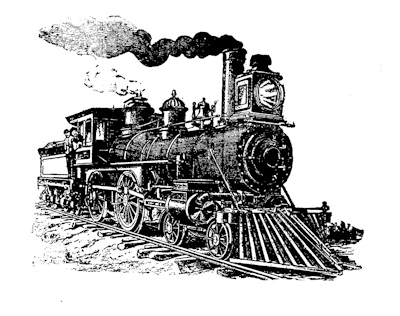


As early as 1850 settlers realized they needed a new mode of transportation. Merchants had to transport more goods faster than was possible by road or boat. Three railway companies in Arkansas obtained charters within the early 1850s. However, the first one to complete its tracks and run a train over them was the Memphis & Little Rock in 1871. Eighty-six railroad companies formed after the Civil War, planning to reach every county in the state. A few succeeded.
Within the next three decades railroads revolutionized life in this region. New settlements boomed. Between 1874 and 1886 more Arkansas towns sprang up than at any other time. Thousands of acres were cleared. By 1880 the agricultural expansion, coupled with railroad construction, produced numerous small towns.
With the railroad also came an increase in the timber industry. Steep ridges in the Ozark Plateau, which rose from the White River, were covered by enormous stands of oak and hickory, ash and pine. Magnificent cedars were much in demand. Landowners cut their trees and hauled them to the railways for lumber sales.
And then there was mining. Izard County held huge deposits of silica and limestone. Baxter and Marion counties had great lead and zinc ready to be mined. But it took the railways to transport the minerals out to the waiting world.
Railroad construction
in the region was a feat of great engineering because of flooded delta lands and rough hill terrain. By 1880 Arkansas had 859 miles of track and by 1900 it had grown to 2,203 miles. In 1883 the first passenger train went from Newport upriver to Batesville, and in August, 1903, the first passenger train from Batesville traveled upriver to Cotter.
Isolated farmers welcomed the sound of the train's bell and whistle. "It was much easier for the people of Melbourne, Evening Shade and Cave City to get to the railroad at Cushman's than to journey over a rocky, rutted mountain road to Batesville. Even people from as far away as Yellville and Mountain Home found this an important outlet from their hillsides." (from Arkansas Odyssy.)
Railway companies consolidated and reorganized time after time, forming a confusion of new names. Major early railroads crossing this region included the St. Louis & Iron Mountain; the Cairo & Fulton; and the Cairo, Arkansas & Texas Railroad. By 1890 several railways by other names served this region-Missouri Pacific, and its White River Branch; Kansas City Fort Scott & Gulf; Iron Mountain & Southern; Texas & St. Louis; St. Louis & San Francisco; and the Batesville & Brinkley.
Railroad construction was at its peak in the 1930s, but consolidation of lines continued. The St. Louis & Southwestern crossed Woodruff and Poinsett counties. The Burlington Northern ran through Fulton, Sharp, and Poinsett counties. Union Pacific was running through Beebe, Searcy, Bald Knob, Newport, toward Walnut Ridge. And it also ran up the White River from Diaz to Batesville, Guion, Norfork, and Yellville.
In 1993 these three rail lines were still serving the region.
The process of early railroad building:
1. Surveyors made a preliminary, general survey of the terrain.
2. Workmen drove stakes at 200 foot intervals along the proposed rail pathway, with angular changes of direction.
3. Locating Surveyors then drove actual stakes for rail builders at 100 foot intervals and secured the property line.
4. Transit men on construction crews kept record of work performed, the nature of terrain, the type of dirt and rock to be removed. They restaked after grading the rail bed for final gradient and curvature before track laying.
5. Tracks were laid on the rail bed by hand, using large hammers and spikes. Shortly after the turn of the century a large machine was used to lay the tracks.
This railway was chartered as the Pacific Railroad in Missouri in 1849. Later, in 1880 it consolidated into the Missouri Pacific, and in 1890 it acquired another line and became the Missouri Pacific & Iron Mountain Railway. In 1917 it absorbed the St. Louis, Iron Mountain & Southern Railway. Its White River Division descended through this region along the White River through Yellville, Flippin, Cotter, Buffalo, Hayney, Norfork, Herron, Berry, Calico Rock, Creswell, Boswell, Mount Olive, Sylamore, Ruddells, Handford, Guion, Biltmore, Walls Ferry, O'Neal, Earnharts, Cushman, White River, Batesville, Moorefield, Sulphur Rock, Magness, Newark Paroquet, Diaz, Newport. It's main line continued on to Bald Knob, heading toward Little Rock.
In 1955 Missouri Pacific retired its last steam locomotive. In 1982 the Missouri Pacific Railroad Company merged with the Union Pacific Railroad Company, changing its name to Union Pacific System.